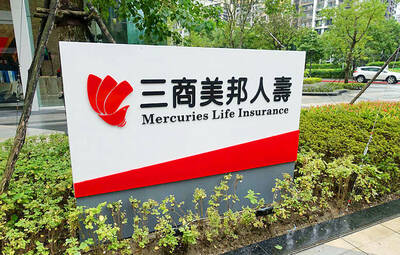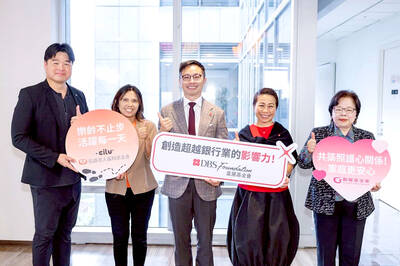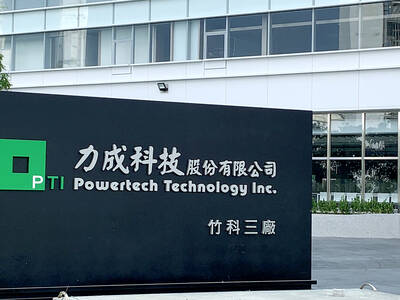As Nike Inc attempts to cut hazardous wastewater discharge in the dyeing process of its supply chain, it is both a challenge and an opportunity for Far Eastern New Century Corp (遠東新世紀).
It is a challenge because investing in new dyeing equipment is very expensive; yet it generates technological advancement, as well as new business opportunities.
Last week, the Taiwanese manufacturer of textile products said that it plans to double its capacity for waterless dyeing to 120 tonnes a month by the end of next year.
Far Eastern New Century has two waterless dyeing machines, which it purchased from Netherlands-based DyeCoo Textil Systems BV. They have a total capacity of 60 tonnes a month and are at its plant in Taoyuan County’s Guanyin Township (觀音).
Far Eastern New Century is scheduled to purchase another two machines by the end of next year, vice president He Kun-lin (何昆麟) said on the sidelines of the Taipei Innovative Textile Application Show (TITAS), a three-day exhibition that ran from Oct. 15 to Oct. 17 in Taipei.
He said a waterless dyeing machine costs about NT$100 million (US$3.29 million), which is about 10 times more than the price of a traditional dyeing machine.
Water-free dyeing currently accounts for 1 to 2 percent of the company’s dyeing capacity and the new technology is now 90 percent as efficient as the traditional dyeing approach.
The company is also seeking to sell fabrics using the new dyeing technology to Japan-based Fast Retailing Co, which operates Uniqlo, and plans to talk with Adidas AG in the near future, according to He.
Among the 10 national teams in the 2014 FIFA World Cup sponsored by Nike, two teams wore soccer kits manufactured by Far Eastern New Century’s water-free dyeing technology, He said, adding that Nike plans to use the new technology to make soccer kits for some of the teams it sponsors in 2016 UEFA Champions League, and all of the teams it sponsors in the 2018 FIFA World Cup.
However, the water-free dyeing technology can only be used to dye polyester, and Far Eastern New Century and DyeCoo are still working on applying the technology to dyeing nylon and cotton, He said.
Far Eastern New Century’s waterless dyeing facility, which was launched on Dec. 3 last year, is the first in the nation and the first in Nike’s supply chain.
The new dyeing technology is named “ColorDry” by Nike.
“ColorDry technology removes water from the dyeing process by using recycled [carbon dioxide] to infuse fabric with intense, saturated color,” Nike said in a press release on June 13, when it launched its first product using waterless dyeing technology.
According to Nike, the traditional dyeing process needs to use 100 to 150 liters of water to dye 1kg of textile.
As the waterless dyeing process is carried out under high pressure to turn carbon dioxide into liquid form, only companies in Taiwan and Thailand have met the safety requirements for running such facilities thus far, according to Taiwan Textile Research Institute (TTRI, 紡研所).
The waterless dyeing facility in Thailand is owned by textile maker Yeh Group’s subsidiary Tong Siang Co, which manufactured fabrics for Adidas AG’s waterless dyeing products launched in 2012, the Taipei-based institute said.
In Taiwan, in addition to Far Eastern New Century, textile makers Formosa Taffeta Co (福懋興業) and Eclat Textile Co (儒鴻) have also installed waterless dyeing facilities, the institute said.
Formosa Taffeta has three machines it purchased from DyeCoo in July and can produce 365,760m of polyester a month, a company official, who declined to be named, said by telephone on Tuesday.
The official said the company’s factory has space to expand its capacity to between 3,657,600m and 4,572,000m of fabrics a month, but it does not have a timetable for the expansion so far.
Eclat has three machines purchased from DyeCoo, with each of them able to process 600kg of fabrics at a time, an industry watcher told the Taipei Times by telephone on Friday.
However, it is still too early for the new technology to generate significant profit for the three Taiwanese companies because the demand for waterless dyeing fabrics is still low, the official said.
“A traditional dyeing facility needs to make 10 tonnes of fabric a month to break even,” he said.
After a report issued by Greenpeace in July 2011 criticized international apparel brands, including Nike, Adidas and Puma SE, for cooperating with two Chinese textile facilities found to be discharging harmful chemicals into water, a group of apparel brands made a commitment to help cut hazardous water discharge in the industry to zero by 2020, according to Zero Discharge of Hazardous Chemicals Group, a platform set up by these brands.

Mercuries Life Insurance Co (三商美邦人壽) shares surged to a seven-month high this week after local media reported that E.Sun Financial Holding Co (玉山金控) had outbid CTBC Financial Holding Co (中信金控) in the financially strained insurer’s ongoing sale process. Shares of the mid-sized life insurer climbed 5.8 percent this week to NT$6.72, extending a nearly 18 percent rally over the past month, as investors bet on the likelihood of an impending takeover. The final round of bidding closed on Thursday, marking a critical step in the 32-year-old insurer’s search for a buyer after years of struggling to meet capital adequacy requirements. Local media reports

US sports leagues rushed to get in on the multi-billion US dollar bonanza of legalized betting, but the arrest of an National Basketball Association (NBA) coach and player in two sprawling US federal investigations show the potential cost of partnering with the gambling industry. Portland Trail Blazers coach Chauncey Billups, a former Detroit Pistons star and an NBA Hall of Famer, was arrested for his alleged role in rigged illegal poker games that prosecutors say were tied to Mafia crime families. Miami Heat guard Terry Rozier was charged with manipulating his play for the benefit of bettors and former NBA player and

The DBS Foundation yesterday announced the launch of two flagship programs, “Silver Motion” and “Happier Caregiver, Healthier Seniors,” in partnership with CCILU Ltd, Hondao Senior Citizens’ Welfare Foundation and the Garden of Hope Foundation to help Taiwan face the challenges of a rapidly aging population. The foundation said it would invest S$4.91 million (US$3.8 million) over three years to foster inclusion and resilience in an aging society. “Aging may bring challenges, but it also brings opportunities. With many Asian markets rapidly becoming super-aged, the DBS Foundation is working with a regional ecosystem of like-minded partners across the private, public and people sectors

BREAKTHROUGH TECH: Powertech expects its fan-out PLP system to become mainstream, saying it can offer three-times greater production throughput Chip packaging service provider Powertech Technology Inc (力成科技) plans to more than double its capital expenditures next year to more than NT$40 billion (US$1.31 billion) as demand for its new panel-level packaging (PLP) technology, primarily used in chips for artificial intelligence (AI) applications, has greatly exceeded what it can supply. A significant portion of the budget, about US$1 billion, would be earmarked for fan-out PLP technology, Powertech told investors yesterday. Its heavy investment in fan-out PLP technology over the past 10 years is expected to bear fruit in 2027 after the technology enters volume production, it said, adding that the tech would